- Calendar
- Online Ticket Sales
- Access
- JA
- EN
The Hara Yasusaburo Collection:
HIROSHIGE VIVID
April 29 to June 12, 2016
*There will be an exhibition change during the course of exhibition
*Download the list of changes in works on display.
The list of changes in worksPDF
Chapter 1
First Public Display: Utagawa Hiroshige’s “Collection of Famous Views of the Sixty-Odd Provinces (Rokujûyoshû Meisho Zue)”
“Collection of Famous Views of the Sixty-Odd Provinces (Rokujûyoshû Meisho Zue)” is a series of works that Hiroshige produced in his later years, portraying famous sites from each of the 68 provinces of Japan, or Gokishichidô (five provinces and seven circuits): the five Home Provinces, the sixteen provinces of Tôkaidô, the eight provinces of Tôsandô, the seven provinces of Hokurikudô, the eight provinces of San’indô, the eight provinces of San’yodô, the six provinces of Nankaidô and the eleven provinces of Seikaidô. The complete set is composed of a total of 70 prints: one for each province, one for Edo (separate from Musashi Province) and a contents page. It was published by Koshimuraya Heisuke (more commonly known as Koshihei for short) between July of 1853 and May of 1856. The contents page was produced by Baisotei Gengyo in September of 1856. Because the famous sites that served as the motifs for these works were scattered throughout Japan, Hiroshige relied on several previously published geographical tomes and picture books, etc. as reference materials. These reference materials were quite diverse, including “Illustrated Guide to the Famous Sites of the Capital (Miyako Meisho Zue),” “Illustrated Guide to the Famous Sites of Settsu (Settsu Meisho Zue),” “Illustrated Guide to the Famous Sites along the Tôkaidô (Tôkaidô Meisho Zue)” and “Hokusai’s Sketches (Hokusai Manga).” Among these, of particular importance as a source material was “Exceptional Views of Mountain and Water Landscapes (Sansui Kikan).” “Exceptional Views of Mountain and Water Landscapes” (cat.no.IV-29) was produced in volumes over the course of 23 years by Fuchigami Kyokko (1753 –1816), who actually travelled throughout the provinces of Japan, sketching the scenery as he went. Based on his firsthand sketches, “Exceptional Views of Mountain and Water Landscapes” is renowned for its faithful depictions of the actual scenery. While modifying and adapting these images, Hiroshige created pictures imbued with a strong sense of realism, creating the illusion of actually viewing the famous sites with one’s own eyes.
In addition, this series also makes skillful and effective use of advanced engraving and printing techniques. For example, the “fukibokashi (wiped shading)” technique, which creates a beautiful gradation of tones, adds greater depth to Hiroshige’s depictions of the sea and rivers as well as the sky. “Atenashibokashi (indeterminate shading),” a variety of “fukibokashi” that requires particular skill on the part of the printer, first came to be used extensively for prints of Hiroshige’s works starting with “Collection of Famous Views of the Sixty-Odd Provinces.” “Awa: Naruto no Fûha (Awa Province: Naruto Whirlpools)” (cat.no.I-55), one of the most important prints in this collection, employs “bokashi (shading)” of indigo that follows the flow of the whirling waves. One can easily imagine that Hara Yasusaburo had a special place in his heart for this print depicting a famous site in his native Tokushima. In addition, perhaps because he was born to a family of merchants who dealt in indigo, Hara’s collection reflects his keen color sense, especially with regard to the shades of indigo that were often used in ukiyo-e.
This is the first exhibition of Hara’s collection of prints of “Collection of Famous Views of the Sixty-Odd Provinces,” a complete set of prints that has never been displayed publicly before now. We hope that you will enjoy this magnificent collection of beautiful prints, many of which still look as they did on the day they were printed.
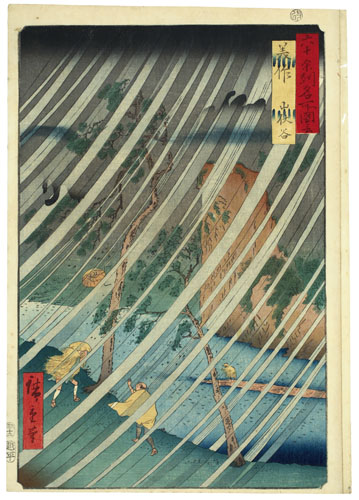
Yamabushidani Valley, Mimasaka Province, from the series Collection of Famous Views of the Sixty-odd Provinces
by Utagawa Hiroshige the Hara Yasusaburo collection
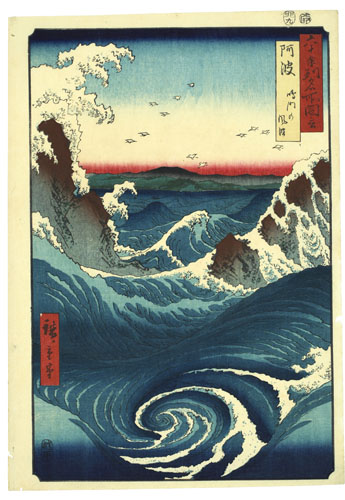
Naruto Whirlpool, Awa Province, from the series Collection of Famous Views of the Sixty-odd Provinces
by Utagawa Hiroshige the Hara Yasusaburo collection
Chapter 2
The Masterpiece of His Final Years: Utagawa Hiroshige’s “One Hundred Famous Views of Edo (Meisho Edo Hyakkei)”
“One Hundred Famous Views of Edo (Meisho Edo Hyakkei)” is a series of landscape works that Hiroshige produced during his final years, portraying famous sites in the city of Edo and also in its outskirts and suburbs. The publisher, Sakanaya Eikichi (more commonly known as Uoei for short), published 118 works bearing Hiroshige’s signature between February of 1856 and October of 1858. After Hiroshige I passed away, “View of the Paulownia Trees at Akasaka on a Rainy Evening (Akasaka Kiribatake, Uchû Yûkei),” a work by Hiroshige II, was published in April of 1859, bringing the total number of pictures to 119. Thus, with the inclusion of the contents page designed by Baisotei Gengyo, a complete set consists of 120 prints in total. In addition to “View of the Paulownia Trees at Akasaka on a Rainy Evening,” there are three other works in the series whose official censor’s seals (i.e. the stamp of approval to publish) bear dates from the month after Hiroshige I died in September of 1858. Some scholars have pointed out that these works also may have been produced by Hiroshige II on behalf of Hiroshige I. One of the major characteristics of this series is the bold compositions of the works, featuring close-up views of objects in the immediate foreground while presenting objects in the background as being smaller, as though viewed from a great distance. Looking at the works in this series in chronological order, one sees that bird’s-eye views were common among the earlier works, while works featuring Hiroshige’s extreme perspective techniques began to increase around July of 1856. In addition, this series is also noted for its extensive use of advanced printing techniques in the early prints, including “atenashibokashi” and “nunomezuri (textile printing),” which involved pressing a cloth to the paper in order to give the prints an uneven texture. “One Hundred Famous Views of Edo” even had an influence on western art, as can be seen in oil paintings by van Gogh that imitate “Sudden Shower over Ohashi Bridge and Atake (Ôhashi, Atake no Yûdachi)” and “Plum Garden in Kameido (Kameido Ume Yashiki).”
Gengyo’s contents page categorizes the works in the series according to the four seasons, an ordering that has generally been followed in exhibitions and publications of the series. However, the contents page was drawn up after Hiroshige’s death and there are examples scattered throughout the series of works that do not match their seasonal classification. Further, if one follows the ordering of the works imposed by Gengyo, one will find that there is no consistency in the dates of the works (as indicated by their official censor’s seals), leading some to question whether the contents page actually reflects Hiroshige’s original intent. Thus, this chapter introduces the works of “One Hundred Famous Views of Edo” by area, in the order that one would see them if one were to tour the actual famous sites of Edo. We hope that you will enjoy this vicarious sightseeing tour of Greater Edo as seen through the eyes of Hiroshige himself.
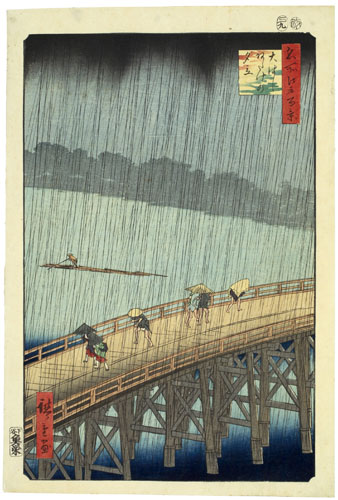
Sudden Shower over Ōhashi Bridge and Atake, from the series One Hundred Famous Views of Edo
by Utagawa Hiroshige the Hara Yasusaburo collection
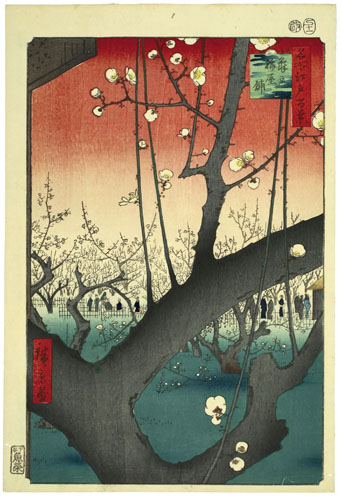
The Plum Garden at Kameido, from the series One Hundred Famous Views of Edo
by Utagawa Hiroshige the Hara Yasusaburo collection
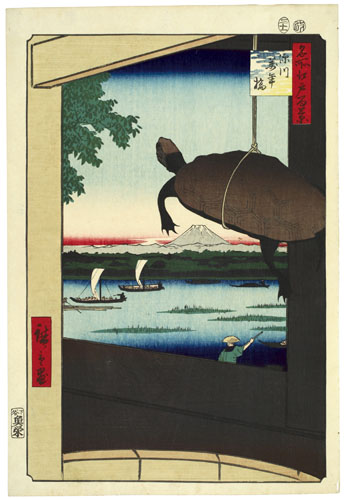
Mannenbashi Bridge at Fukagawa, from the series One Hundred Famous Views of Edo
by Utagawa Hiroshige the Hara Yasusaburo collection
Chapter 3
The Mythical Series: Katsushika Hokusai’s
“One Thousand Pictures of the Sea (Chie no Umi)”
Long before Hiroshige became a leading figure in the world of ukiyo-e landscapes, Katsushika Hokusai attained enduring popularity in the genre. His “One Thousand Pictures of the Sea (Chie no Umi)” is a series depicting waterfront scenery throughout Japan, focusing on fishery work and the shapes of the water and shorelines. The prints are of medium-size (one size smaller than the more common large-sized prints) and not many of them still exist. Nonetheless, they are highly redeemed for their artistic merit. Thought to have been published immediately after the great success of “Thirty-Six Views of Mount Fuji (Fugaku Sanjûrokkei),” this series takes its name from a play on words: written with different characters, “chie” means “knowledge,” making the title a reference to the expression that “knowledge is as deep as the sea.” There are ten known prints in the series: “Line-Fishing in the Miyato River (Miyatogawa Naganawa),” “Noboto in Shimôsa Province (Shimôsa Nobuto),” “Chôshi in Shimôsa Province (Sôshû Chôshi),” “Uraga in Sagami Province (Sôshû Uraga),” “The Tone River in Shimôsa Province (Sôshû Tonegawa),” “Basket-Fishing in the Kinu River (Kinugawa Hachifuse),” “Whaling off the Gotô Islands (Gotô Kujira Tsuki),” “Fishing by Torchlight in Kai Province (Kôshû Hiburi),” “Fly-Fishing (Kabari- Nagashi)” and “Fishing with Handheld Nets (Machi-Ami).” In addition to these, there are later, revised prints of “Kazusa Bay (Kazusa Ura)” and “Shingawa,” as well as draft sketches. As few prints of this series remain, there are only a handful of collections that house a complete set of all ten. In this chapter, we will introduce all ten of these priceless works.
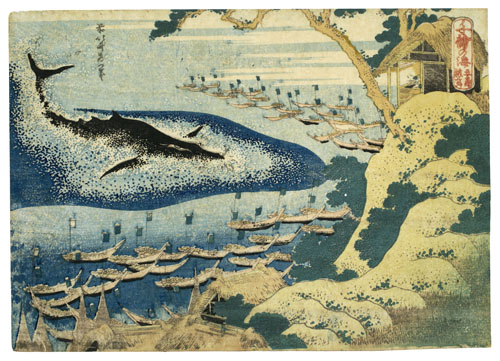
Whaling off the Gotō Islands, from the series One Thousand Pictures of the Sea
by Katsushika Hokusai the Hara Yasusaburo collection
Chapter 4
Masterpieces of the “Landscapes of Famous Views” Genre:
Hiroshige alongside Katsushika Hokusai and Utagawa Kuniyoshi
Throughout his life, Hiroshige produced numerous masterpieces in the “landscapes of famous views” genre of ukiyo-e. After making a name for himself in his thirties with“ The Fifty-Three Stations of the Tôkaidô (Tôkaidô Gojûsan-tsugi no Uchi),” he went on to further solidify his position as a master of ukiyo-e landscapes. He later produced a set of triptychs, large prints whose panoramic frames depicted snow over Kiso Road, a view of the moon over Kanazawa Hakkei and the famous Naruto Whirlpools from a birds-eye view, respectively, in “Mountain River on the Kiso Road (Kisoji no Sansen),” “Night View of Kanazawa Hakkei (Buyô Kanazawa Hasshô Yakei)” and “View of the Naruto Whirlpools at Awa (Awa Naruto no Fûkei).” This set of triptychs “Setsugekka (Snow, Moon and Flowers)” is a series of works with a dynamic that was well suited to this late stage of his career. In his later years, Hiroshige also demonstrated a remarkable ability to produce outstanding works in the genre of original paintings (i.e. not prints).
In addition to these, this chapter further introduces a selection of masterpieces by Katsushika Hokusai and Utagawa Kuniyoshi, focusing on examples chosen from their serial works. In addition to “Thirty-Six Views of Mount Fuji (Fugaku Sanjûrokkei),” Hokusai's most famous masterpiece, which he produced in his seventies, this chapter also introduces his “Rare Views of Famous Bridges in the Provinces (Shokoku Meikyô Kiran),” featuring real and fictitious bridges from throughout Japan, and his “A Tour of the Waterfalls of the Provinces (Shokoku Taki Meguri),” which explores Japans famous waterfalls. This chapter also introduces works by Kuniyoshi (who was born in the same year as Hiroshige), such as his “The Eastern Capital (Tôto)” and “Famous Views in the Eastern Capital (Tôto Meisho)” series, which portray famous sites in Edo, as well as his “Okane, the Brave Woman in Ômi Province (Ômi no Kuni no Yûfu Okane)” and other noted works. We hope that you will enjoy viewing the competition that played out between these three great ukiyo-e masters who flourished during the late Edo Period.
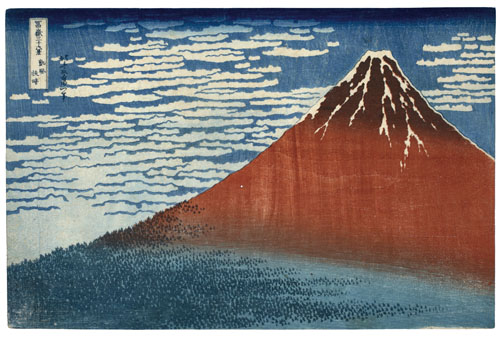
Warm Breeze, Fair Weather (the Red Fuji), from the series Thirty-six Views of Mount Fuji
by Katsushika Hokusai the Hara Yasusaburo collection
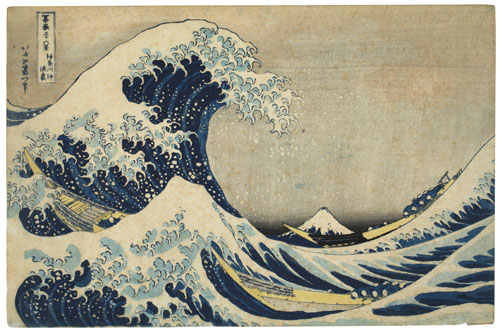
Under the Wave off Kanagawa (the Great Wave), from the series Thirty-six Views of Mount Fuji
by Katsushika Hokusai the Hara Yasusaburo collection
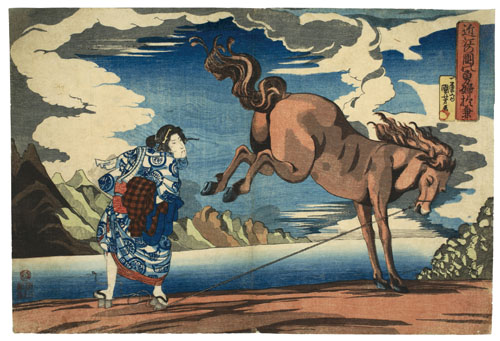
Okane, the Brave Woman in Ōmi Province
by Utagawa Kuniyoshi the Hara Yasusaburo collection
*Unauthorized reproduction or use of texts or images from this site is prohibited.
2024 January
- Exhibition
- Closed
- Tea Ceremony
- Mon
- Tue
- Wed
- Thu
- Fri
- Sat
- Sun
- 1
- 2
- 3
- 4
- 5
- 6
- 7
- 8
- 9
- 10
- 11
- 12
- 13
- 14
- 15
- 16
- 17
- 18
- 19
- 20
- 21
- 22
- 23
- 24
- 25
- 26
- 27
- 28
- 29
- 30
- 31
2024 February
- Exhibition
- Closed
- Tea Ceremony
- Mon
- Tue
- Wed
- Thu
- Fri
- Sat
- Sun
- 1
- 2
- 3
- 4
- 5
- 6
- 7
- 8
- 9
- 10
- 11
- 12
- 13
- 14
- 15
- 16
- 17
- 18
- 19
- 20
- 21
- 22
- 23
- 24
- 25
- 26
- 27
- 28
- 29
2024 March
- Exhibition
- Closed
- Tea Ceremony
- Mon
- Tue
- Wed
- Thu
- Fri
- Sat
- Sun
- 1
- 2
- 3
- 4
- 5
- 6
- 7
- 8
- 9
- 10
- 11
- 12
- 13
- 14
- 15
- 16
- 17
- 18
- 19
- 20
- 21
- 22
- 23
- 24
- 25
- 26
- 27
- 28
- 29
- 30
- 31
2024 April
- Exhibition
- Closed
- Tea Ceremony
- Mon
- Tue
- Wed
- Thu
- Fri
- Sat
- Sun
- 1
- 2
- 3
- 4
- 5
- 6
- 7
- 8
- 9
- 10
- 11
- 12
- 13
- 14
- 15
- 16
- 17
- 18
- 19
- 20
- 21
- 22
- 23
- 24
- 25
- 26
- 27
- 28
- 29
- 30
2024 May
- Exhibition
- Closed
- Tea Ceremony
- Mon
- Tue
- Wed
- Thu
- Fri
- Sat
- Sun
- 1
- 2
- 3
- 4
- 5
- 6
- 7
- 8
- 9
- 10
- 11
- 12
- 13
- 14
- 15
- 16
- 17
- 18
- 19
- 20
- 21
- 22
- 23
- 24
- 25
- 26
- 27
- 28
- 29
- 30
- 31
2024 June
- Exhibition
- Closed
- Tea Ceremony
- Mon
- Tue
- Wed
- Thu
- Fri
- Sat
- Sun
- 1
- 2
- 3
- 4
- 5
- 6
- 7
- 8
- 9
- 10
- 11
- 12
- 13
- 14
- 15
- 16
- 17
- 18
- 19
- 20
- 21
- 22
- 23
- 24
- 25
- 26
- 27
- 28
- 29
- 30
2024 July
- Exhibition
- Closed
- Tea Ceremony
- Mon
- Tue
- Wed
- Thu
- Fri
- Sat
- Sun
- 1
- 2
- 3
- 4
- 5
- 6
- 7
- 8
- 9
- 10
- 11
- 12
- 13
- 14
- 15
- 16
- 17
- 18
- 19
- 20
- 21
- 22
- 23
- 24
- 25
- 26
- 27
- 28
- 29
- 30
- 31
2024 August
- Exhibition
- Closed
- Tea Ceremony
- Mon
- Tue
- Wed
- Thu
- Fri
- Sat
- Sun
- 1
- 2
- 3
- 4
- 5
- 6
- 7
- 8
- 9
- 10
- 11
- 12
- 13
- 14
- 15
- 16
- 17
- 18
- 19
- 20
- 21
- 22
- 23
- 24
- 25
- 26
- 27
- 28
- 29
- 30
- 31
2024 September
- Exhibition
- Closed
- Tea Ceremony
- Mon
- Tue
- Wed
- Thu
- Fri
- Sat
- Sun
- 1
- 2
- 3
- 4
- 5
- 6
- 7
- 8
- 9
- 10
- 11
- 12
- 13
- 14
- 15
- 16
- 17
- 18
- 19
- 20
- 21
- 22
- 23
- 24
- 25
- 26
- 27
- 28
- 29
- 30
2024 October
- Exhibition
- Closed
- Tea Ceremony
- Mon
- Tue
- Wed
- Thu
- Fri
- Sat
- Sun
- 1
- 2
- 3
- 4
- 5
- 6
- 7
- 8
- 9
- 10
- 11
- 12
- 13
- 14
- 15
- 16
- 17
- 18
- 19
- 20
- 21
- 22
- 23
- 24
- 25
- 26
- 27
- 28
- 29
- 30
- 31
2024 November
- Exhibition
- Closed
- Tea Ceremony
- Mon
- Tue
- Wed
- Thu
- Fri
- Sat
- Sun
- 1
- 2
- 3
- 4
- 5
- 6
- 7
- 8
- 9
- 10
- 11
- 12
- 13
- 14
- 15
- 16
- 17
- 18
- 19
- 20
- 21
- 22
- 23
- 24
- 25
- 26
- 27
- 28
- 29
- 30
2024 December
- Exhibition
- Closed
- Tea Ceremony
- Mon
- Tue
- Wed
- Thu
- Fri
- Sat
- Sun
- 1
- 2
- 3
- 4
- 5
- 6
- 7
- 8
- 9
- 10
- 11
- 12
- 13
- 14
- 15
- 16
- 17
- 18
- 19
- 20
- 21
- 22
- 23
- 24
- 25
- 26
- 27
- 28
- 29
- 30
- 31
2025 January
- Exhibition
- Closed
- Tea Ceremony
- Mon
- Tue
- Wed
- Thu
- Fri
- Sat
- Sun
- 1
- 2
- 3
- 4
- 5
- 6
- 7
- 8
- 9
- 10
- 11
- 12
- 13
- 14
- 15
- 16
- 17
- 18
- 19
- 20
- 21
- 22
- 23
- 24
- 25
- 26
- 27
- 28
- 29
- 30
- 31
2025 February
- Exhibition
- Closed
- Tea Ceremony
- Mon
- Tue
- Wed
- Thu
- Fri
- Sat
- Sun
- 1
- 2
- 3
- 4
- 5
- 6
- 7
- 8
- 9
- 10
- 11
- 12
- 13
- 14
- 15
- 16
- 17
- 18
- 19
- 20
- 21
- 22
- 23
- 24
- 25
- 26
- 27
- 28
2025 March
- Exhibition
- Closed
- Tea Ceremony
- Mon
- Tue
- Wed
- Thu
- Fri
- Sat
- Sun
- 1
- 2
- 3
- 4
- 5
- 6
- 7
- 8
- 9
- 10
- 11
- 12
- 13
- 14
- 15
- 16
- 17
- 18
- 19
- 20
- 21
- 22
- 23
- 24
- 25
- 26
- 27
- 28
- 29
- 30
- 31
2025 April
- Exhibition
- Closed
- Tea Ceremony
- Mon
- Tue
- Wed
- Thu
- Fri
- Sat
- Sun
- 1
- 2
- 3
- 4
- 5
- 6
- 7
- 8
- 9
- 10
- 11
- 12
- 13
- 14
- 15
- 16
- 17
- 18
- 19
- 20
- 21
- 22
- 23
- 24
- 25
- 26
- 27
- 28
- 29
- 30
2025 May
- Exhibition
- Closed
- Tea Ceremony
- Mon
- Tue
- Wed
- Thu
- Fri
- Sat
- Sun
- 1
- 2
- 3
- 4
- 5
- 6
- 7
- 8
- 9
- 10
- 11
- 12
- 13
- 14
- 15
- 16
- 17
- 18
- 19
- 20
- 21
- 22
- 23
- 24
- 25
- 26
- 27
- 28
- 29
- 30
- 31
2025 June
- Exhibition
- Closed
- Tea Ceremony
- Mon
- Tue
- Wed
- Thu
- Fri
- Sat
- Sun
- 1
- 2
- 3
- 4
- 5
- 6
- 7
- 8
- 9
- 10
- 11
- 12
- 13
- 14
- 15
- 16
- 17
- 18
- 19
- 20
- 21
- 22
- 23
- 24
- 25
- 26
- 27
- 28
- 29
- 30
2025 July
- Exhibition
- Closed
- Tea Ceremony
- Mon
- Tue
- Wed
- Thu
- Fri
- Sat
- Sun
- 1
- 2
- 3
- 4
- 5
- 6
- 7
- 8
- 9
- 10
- 11
- 12
- 13
- 14
- 15
- 16
- 17
- 18
- 19
- 20
- 21
- 22
- 23
- 24
- 25
- 26
- 27
- 28
- 29
- 30
- 31
2025 August
- Exhibition
- Closed
- Tea Ceremony
- Mon
- Tue
- Wed
- Thu
- Fri
- Sat
- Sun
- 1
- 2
- 3
- 4
- 5
- 6
- 7
- 8
- 9
- 10
- 11
- 12
- 13
- 14
- 15
- 16
- 17
- 18
- 19
- 20
- 21
- 22
- 23
- 24
- 25
- 26
- 27
- 28
- 29
- 30
- 31
2025 September
- Exhibition
- Closed
- Tea Ceremony
- Mon
- Tue
- Wed
- Thu
- Fri
- Sat
- Sun
- 1
- 2
- 3
- 4
- 5
- 6
- 7
- 8
- 9
- 10
- 11
- 12
- 13
- 14
- 15
- 16
- 17
- 18
- 19
- 20
- 21
- 22
- 23
- 24
- 25
- 26
- 27
- 28
- 29
- 30
2025 October
- Exhibition
- Closed
- Tea Ceremony
- Mon
- Tue
- Wed
- Thu
- Fri
- Sat
- Sun
- 1
- 2
- 3
- 4
- 5
- 6
- 7
- 8
- 9
- 10
- 11
- 12
- 13
- 14
- 15
- 16
- 17
- 18
- 19
- 20
- 21
- 22
- 23
- 24
- 25
- 26
- 27
- 28
- 29
- 30
- 31
2025 November
- Exhibition
- Closed
- Tea Ceremony
- Mon
- Tue
- Wed
- Thu
- Fri
- Sat
- Sun
- 1
- 2
- 3
- 4
- 5
- 6
- 7
- 8
- 9
- 10
- 11
- 12
- 13
- 14
- 15
- 16
- 17
- 18
- 19
- 20
- 21
- 22
- 23
- 24
- 25
- 26
- 27
- 28
- 29
- 30
2025 December
- Exhibition
- Closed
- Tea Ceremony
- Mon
- Tue
- Wed
- Thu
- Fri
- Sat
- Sun
- 1
- 2
- 3
- 4
- 5
- 6
- 7
- 8
- 9
- 10
- 11
- 12
- 13
- 14
- 15
- 16
- 17
- 18
- 19
- 20
- 21
- 22
- 23
- 24
- 25
- 26
- 27
- 28
- 29
- 30
- 31
